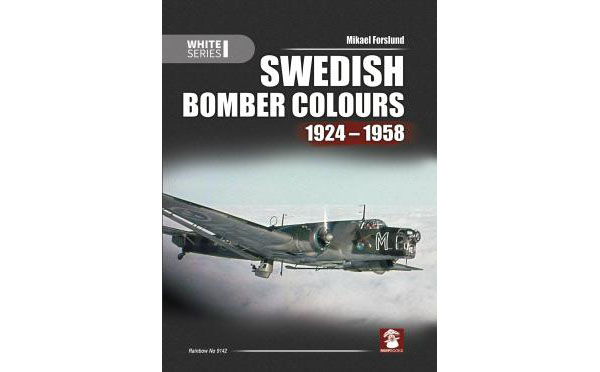
Swedish Bomber Colours 1924-1958
By Chris Banyai-Riepl
White Series
Author: Mikael Forslund
Publisher: MMP Books
ISBN: 978-83-65958-37-2
Binding: Hardcover
Pages: 296
Aircraft in the Swedish Air Force have been an eclectic mix of designs both foreign and domestic. Because of these varied sources, the colors worn by various types over the decades have varied quite a bit. This latest book from Mushroom Model Publications helps shed light on this challenging subject by focusing on bomber aircraft, thus forming a nice counterpart to their earlier release on Swedish Fighter colors.
Swedish bombers have a shorter life span than their fighter arm, with Sweden giving up on dedicated bomber aircraft at the advent of the jet age. This made sense, as jet aircraft could more easily operate in a dual capacity as both fighters and bombers. Thus this book ranges from the early 1920s to the late 1950s, and all the types covered are piston-engined propeller types. The book looks at these types chronologically according to their Swedish designations, from the B 1 through to the B 18.
The book begins with the first bombers, those being the Fiat BR and BR 1. These were not the first bombers purchased by Sweden, but they were the first ones used in that role (earlier bomber types were purchased but used solely for training). The differences between the BR and BR 1 were minimal, but enough to warrant a new mark, and in Swedish service these were known as the B 1 and B 2. These aircraft formed the main bomber force of Sweden until the mid-1930s when more modern types arrived, and their colors were simple, being primarily varnished plywood and clear doped linen fabric surfaces.
Next in line is the B 3, the Swedish designation for the Junkers Ju 86K. This plane saw extensive service in Swedish service, operating throughout the Second World War and beyond. In addition to a long life, the plane also lent itself well to testing, and this process also extended to colors and markings. As such, there were several camouflage schemes worn by the type, including the original German tricolor scheme of RLM 61/62/63 to white winter camouflages, post-war green over gray, and even natural metal.
Moving on to the B 4, this one takes a step backwards and returns to biplane construction as Sweden added a third nation's output to their bomber force. This was in the form of the Hawker Hart biplane from Britain, a stable bomber aircraft that quickly saw itself fall behind as monoplanes moved into the forefront during the Second World War. Still, Sweden kept the type on hand until 1947, with several examples operating in a torpedo bomber role as the S 7.
Not happy with having three nations' aircraft, Sweden then turned their eyes to North America, and both the B 5 and B 6 were from the United States. The B 5 was the Northrop 8A-1, a single-engined dive bomber, while the B 6 was the Seversky/Republic 2PA. Only two B 6 aircraft served in Sweden (with one lost in a crash), while over 100 Northrop types flew for the Flygvapnet. In both cases the colors and markings were primarily green over blue gray, with some variations for both types.
Sweden then returned to their Italian roots and picked up the Caproni Ca 313 and gave it their designation of B 16. These aircraft operated throughout the Second World War and beyond, and through it all maintained their Italian color scheme of light brown, dark green, and dark brown. So, to sum up, during the Second World War, Sweden had five bomber aircraft from four different nations, all wearing anywhere from five to seven different types of camouflages.
Just to add to that, the last two bomber aircraft, the B 17 and B 18, also saw service during the Second World War, and were indigenous designs from Saab. Luckily, these did not add even more camouflage colors to the bomber fleet, as they were finished in the standard Swedish aircraft colors of green over blue gray. The B 17 also saw some service outside of Sweden's borders, with Ethiopia purchasing the type. The B 18 was the last bomber in Swedish service, and it operated up until 1958.
Each one of these aircraft gets a detailed history of its procurement by Sweden (or, in the case of the B 17 and B 18, a history of its production). Following this useful introduction, the text then delves into an analysis of the colors used by the type, which for some is fairly short. Balancing out the text are the photos, and these are truly remarkable, especially the early color photos. Finally, to further accent the color aspect, there are plenty of color profile illustrations to showcase some standard and some interesting examples.
For anyone interested in Swedish aircraft, this is a must-have book. The information is nicely presented and quite thorough, and the color work in the form of illustrations and photographs adds a great deal of value. My thanks to Mushroom Model Publications for the review copy.
